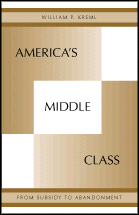
America's Middle Class
From Subsidy to Abandonment
1998
Tags: Political Science, Sociology
244 pp $22.50
ISBN 978-0-89089-830-7
In 1979 Kreml's first book, The Middle Class Burden, discussed the vulnerability of the American middle class and predicted that it would begin to suffer from corporate downsizing.
In the first seven chapters of this follow-up study, Kreml reiterates his original predictions, arguing that a goodly part of the size of the middle class was not a result of economic necessity for large private sector bureaucracies such as banking, insurance and real estate. Instead, the inflated size of the middle class was due to the fact that the American political system — in concert with the American competitive and individualistic ethic — needed the ratification of a majority of citizens. With this goal in mind, corporations were encouraged to place large numbers of people into white collar employment.
The last two chapters of America's Middle Class bring the first edition up to date as Kreml shows how his first work was prophetic. He explains that by the 1990's, important factors such as the computer age, foreign competition, and the weakness of labor unions placed the middle class in a far weaker position. In addition, the structure of the federal government, particularly the Congress, became fragmented, increasing the number of committees and subcommittees and allowing individuals within the government to become entrepreneurial in their approach to politics. The fragmentation — which Kreml refers to as "undemocratic decentralization" — meant that large corporations could downsize without fear of political retribution, thus leading to the abandonment of America's middle class.

